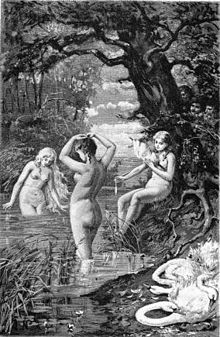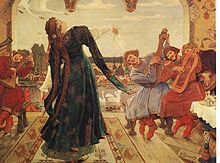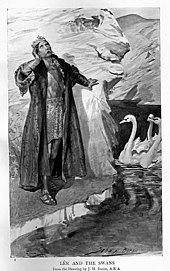Is It Possible To Shapeshift Into An Animal

Valkyries, having shed their swan skins, appear as swan maidens.
Therianthropy is the mythological ability of man beings to metamorphose into other animals by means of shapeshifting. It is possible that cave drawings found at Les Trois Frères, in France, describe ancient beliefs in the concept.[ citation needed ]
The best-known form of therianthropy is found in stories of werewolves.
Etymology [edit]
The term "therianthropy" comes from the Greek theríon [θηρίον], meaning "wild brute" or "beast" (implicitly mammalian), and anthrōpos [ἄνθρωπος], meaning "homo being". It was used to refer to animal transformation sociology of Europe every bit early as 1901.[1] Sometimes the term "zoanthropy" is used instead.[2]
Therianthropy was used to describe spiritual beliefs in animal transformation in a 1915 Japanese publication, A History of the Japanese People from the Earliest Times to the Stop of the Meiji Era.[iii] I source, The Human being Predator, raises the possibility the term may take been used equally early on every bit the 16th century in criminal trials of suspected werewolves.[4]
History of therianthropy and theriocephaly [edit]
Therianthropy refers to the fantastical, or mythological, ability of some humans to change into animals.[5] Therianthropes are said to change forms via shapeshifting. Therianthropy has long existed in mythology, and seems to be depicted in ancient cave drawings[6] such every bit The Sorcerer, a pictograph executed at the Palaeolithic cave drawings establish in the Pyrénées at the Les Trois Frères, France, archeological site.
'Theriocephaly' (Gr. "animate being headedness") refers to beings which have an animal head attached to an anthropomorphic, or human, body; for instance, the animal-headed forms of gods depicted in ancient Egyptian religion (such as Ra, Sobek, Anubis).
Mythology of human being shapeshifting [edit]

Shapeshifting in folklore, mythology and anthropology generally refers to the alteration of physical appearance from that of a human to that of another species. Lycanthropy, the transformation of a man into a wolf (or werewolf), is probably the best known form of therianthropy, followed past cynanthropy (transformation into a dog) and ailuranthropy (transformation into a cat).[7] Werehyenas are present in the stories of several African and Eurasian cultures. Ancient Turkic legends from Asia talk of grade-changing shamans known as kurtadams, which translates to "wolfman".[ commendation needed ] Ancient Greeks wrote of kynanthropy, from κύων kyōn [8] (or "dog"), which practical to mythological beings able to alternate betwixt domestic dog form and human form, or who possessed combined dog and human anatomical features.[ citation needed ]
The term existed by at least 1901, when information technology was practical to stories from People's republic of china about humans turning into dogs, dogs becoming people, and sexual relations between humans and canines.[9] Anthropologist David Gordon White called Central Asia the "vortex of cynanthropy" because races of dog-men were habitually placed there past ancient writers. The weredog or cynanthrope is also known in Timor. It is described as a human being-canine shapeshifter who is capable of transforming other people into animals, fifty-fifty against their will.[ citation needed ]
European folklore features werecats, who can transform into panthers or domestic cats of an enlarged size.[10] African legends describe people who turn into lions or leopards, while Asian werecats are typically depicted as becoming tigers.[ citation needed ]
Skin-walkers and naguals [edit]
Some Native American and Starting time Nation legends talk well-nigh skin-walkers—people with the supernatural ability to plough into any animal they desire. To do so, however, they first must be wearing a pelt of the specific animal. In the folk religion of Mesoamerica, a nagual (or nahual) is a homo who has the power to magically turn themselves into beast forms—most unremarkably donkeys, turkeys, and dogs—but can likewise transform into more powerful jaguars and pumas.[ commendation needed ]
Animal ancestors [edit]

Stories of humans descending from animals are found in the oral traditions for many tribal and association origins. Sometimes the original animals had assumed man course in order to ensure their descendants retained their homo shapes; other times the origin story is of a human being marrying a normal animal.
North American indigenous traditions mingle the ideas of acquit ancestors and ursine shapeshifters, with bears often beingness able to shed their skins to assume human form, marrying human being women in this guise. The offspring may be creatures with combined anatomy, they may be very cute children with uncanny strength, or they may be shapeshifters themselves.[11]
P'an Hu is represented in various Chinese legends as a supernatural canis familiaris, a domestic dog-headed man, or a canine shapeshifter that married an emperor's daughter and founded at to the lowest degree one race. When he is depicted as a shapeshifter, all of him can become human except for his caput. The race(due south) descended from P'an Hu were often characterized by Chinese writers as monsters who combined human and dog anatomy.[12]
In Turkic mythology, the wolf is a revered brute. The Turkic legends say the people were descendants of wolves. The legend of Asena is an old Turkic myth that tells of how the Turkic people were created. In the legend, a pocket-size Turkic hamlet in northern China is raided by Chinese soldiers, with ane baby left behind. An erstwhile she-wolf with a sky-blue mane named Asena finds the baby and nurses him. She after gives birth to one-half-wolf, half-human cubs who are the ancestors of the Turkic people.[xiii] [14]
Shamanism [edit]
Ethnologist Ivar Lissner theorised that cavern paintings of beings with human and non-human animal features were not concrete representations of mythical shapeshifters, but were instead attempts to depict shamans in the process of acquiring the mental and spiritual attributes of various beasts.[15] Religious historian Mircea Eliade has observed that beliefs regarding animal identity and transformation into animals are widespread.[16]
Animal spirits [edit]

In Melanesian cultures there exists the belief in the tamaniu or atai, which describes the animate being counterpart to a person.[17] Specifically among the Solomon Islands in Melanesia, the term atai means "soul" in the Mota language and is closely related to the term ata, pregnant a "reflected epitome" in Maori and "shadow" in Samoan. Terms relating to the "spirit" in these islands such every bit figona and vigona convey a beingness that has not been in human form[xviii] The beast counterpart depicted, may take the form of an eel, shark, cadger, or some other creature. This brute is considered to exist corporeal, and can understand human spoken language. It shares the same soul as its master. This concept is establish in similar legends which have many characteristics typical of shapeshifter tales. Among these characteristics is the theory that death or injury would impact both the homo and fauna form at once.[17]
Psychiatric aspects [edit]
Among a sampled set of psychiatric patients, the conventionalities of being part animate being, or clinical lycanthropy, is generally associated with astringent psychosis, but not ever with any specific psychiatric diagnosis or neurological findings.[19] Others regard clinical lycanthropy as a delusion in the sense of the self-disorder found in affective and schizophrenic disorders, or as a symptom of other psychiatric disorders.[xx]
Modern therianthropy [edit]
Therians are individuals who believe or experience that they are non-human animals in a non-biological sense. While therians mainly aspect their experiences of therianthropy to either spirituality or psychology, the manner in which they consider their therian identity is non a defining characteristic of therianthropy; as long as a person identifies their sense of self as being that of a non-human being animal, they can be considered a therian.[21] [22] The fauna which a therian identifies as is known by the community as a "theriotype", and this tin refer to either the animate being they place as or, more specifically, their ain non-human animal identity. For example, a therian who believes in reincarnation may use the word "theriotype" to refer specifically to their past life or, more generally, to point that they are speaking about the creature species they identify as. Therians often use the term "species dysphoria" to depict their feelings of disconnect from their human being bodies and their underlying desire to alive every bit their theriotype.[23] The concept of species dysphoria has often been compared to gender dysphoria, in that there is a similar sense of incongruence betwixt the person's physical body and their internal sense of self. Some non-man identifying people oppose this comparison, stating that "they are separate ... identities". Others intentionally parallel the two, highlighting the similarities.[24] Species dysphoria, or species identity disorder, has been proposed every bit a mental disorder.[25] A now-defunct therian website suggested a criteria for a diagnosis, based on the diagnosis of gender dysphoria. Gerbasi et al. noted the "hitting" similarities between species and gender dysphoria, leading them to tentatively advise a medical diagnosis of species identity disorder.[25] Others take compared species dysphoria with body dysmorphic disorder, terming it "species dysmorphia" instead.[26] A participant in Proctor'south paper stated that they would consider information technology a form of neurodiversity, rather than a medical diagnosis, "unless it had major and negative impact on someone's life".[27] The identity "transspecies" is used by some, furthering the similarities betwixt identifying equally a different species and a different gender.[28]
Prevalence [edit]
In an online community survey of 523 non-human identifying people, 75.1% said they experienced species dysphoria, and eight.2% were unsure.[29] In a survey of 408 furries, a quarter responded that they experienced species dysphoria (although furries and otherkin are two separate, but often intersecting, groups).[30]
Shifting [edit]
Many therians describe experiences of temporarily feeling more in bear upon with their theriotype than they exercise at other times, and this phenomenon is known by the community every bit "shifting", with the experiences existence known equally "shifts". Shifts can vary indefinitely in the length of time for which they are experienced, and the intensity with which they are felt. They can also be triggered intentionally, or unintentionally, usually by stimuli relating to a person'southward theriotype. While shifting is often regarded every bit a positive feel, the disruption caused by unintentional triggers, and heightened feelings of species-dysphoria, can besides lead to therians experiencing shifts as negative experiences too. Shifts are normally experienced in a state of consciousness, although dream shifts (in which a therian might really believe they have the body of their theriotype) are an exception to this. Some therians attribute their knowledge of their ain therianthropic identities to their experiences of shifting. For example, a wolf therian might begin to identify every bit a wolf subsequently experiencing dreams in which their body takes the form of a wolf.
The therian community is generally considered to be a subculture of the otherkin customs, which consists of individuals who identify every bit or connect with whatsoever fictional or non-fictional being. However, unlike otherkin, therians do not identify equally fictional beings, and the two movements are culturally and historically distinct.[23] [ folio needed ]
Run across also [edit]
- Therianthropy in pop culture
- Banjhakri and Banjhakrini
- Cynanthropy
- Furry fandom
- Kelpie
- Nagual
- Otherkin
- Selkie
- Shapeshifting
- Skin-walker
- Theriocephaly
- Werecat
- Werewolf
- Werehyena
- Werejaguar
- Wererat
- Zoomorphism
- Human being–animal hybrid
Notes and references [edit]
- ^ De Groot, J.J.G. (1901). The Religious System of China: Volume IV. Leiden: Brill. p. 171.
- ^ Guiley, R.E. (2005). The Encyclopedia of Vampires, Werewolves & Other Monsters. New York: Facts on File. p. 192. ISBN0-8160-4685-9.
- ^ Brinkley, Frank; Dairoku Kikuchi (1915). A History of the Japanese People from the Earliest Times to the End of the Meiji Era. The Encyclopædia Britannica Co.
therianthropy.
- ^ Ramsland, Katherine (2005). The Human Predator: A Historical Chronicle of Serial Murder and Forensic Investigation. Berkley Hardcover. ISBN0-425-20765-X.
- ^ Edward Podolsky (1953). Encyclopedia of Aberrations: A Psychiatric Handbook. Philosophical Library.
- ^ "Trois Freres". Encyclopædia Britannica . Retrieved 2006-12-06 .
- ^ Greene, R. (2000). The Magic of Shapeshifting. York Beach, ME: Weiser. p. 229. ISBN1-57863-171-8.
- ^ kynanthropy; Woodhouse's English-Greek Dictionary; (1910)
- ^ De Groot, J.J.Chiliad. (1901). The Religious System of China: Volume IV. Leiden: Brill. p. 184.
- ^ Greene, Rosalyn (2000). The Magic of Shapeshifting. Weiser. p. 9.
- ^ Pijoan, T. (1992). White Wolf Woman & Other Native American Transformation Myths . Little Stone: August House. p. 79. ISBN0-87483-200-4.
- ^ White, D.G. (1991). Myths of the Canis familiaris-Homo . Chicago: The University of Chicago Printing. p. 150. ISBN0-226-89509-2.
- ^ Cultural Life – Literature Turkey Interactive CD-ROM; 2007-08-eleven.
- ^ T.C. Kultur Bakanligi; Nevruz Celebrations in Turkey and Central Asia Archived 2007-04-04 at the Wayback Machine; Ministry building of Culture, Republic of Turkey; accessed 2007-08-11
- ^ Steiger, B. (1999). The Werewolf Book: The Encyclopedia of Shape-Shifting Beings. Farmington Hills, MI: Visible Ink. ISBN1-57859-078-seven.
- ^ Eliade, Mircea (1965). Rites and Symbols of Initiation: the mysteries of birth and rebirth. Harper & Row.
- ^ a b Hamel, F. (1969). Human Animals, Werewolves & Other Transformations. New Hyde Park, NY: University Books. p. 21. ISBN0-8216-0092-3.
- ^ Ivens, Walter (January 1934). "The Variety of Civilization in Melanesia". The Journal of the Royal Anthropological Institute of Keen United kingdom of great britain and northern ireland and Ireland. 64: 45–56. doi:10.2307/2843946. JSTOR 2843946.
- ^ Keck PE, Pope HG, Hudson JI, McElroy SL, Kulick AR (February 1988). "Lycanthropy: live and well in the twentieth century". Psychol Med. 18 (1): 113–20. doi:10.1017/S003329170000194X. PMID 3363031.
- ^ Garlipp, P; Godecke-Koch T; Dietrich DE; Haltenhof H. (January 2004). "Lycanthropy—psychopathological and psychodynamical aspects". Acta Psychiatrica Scandinavica. 109 (i): 19–22. doi:ten.1046/j.1600-0447.2003.00243.x. PMID 14674954. S2CID 41324350.
- ^ Laycock, Joseph P. (2012). "Nosotros Are Spirits of Another Sort". Nova Religio: The Journal of Culling and Emergent Religions. xv (3): 65–90. doi:10.1525/nr.2012.15.3.65.
- ^ Cohen, D. (1996). Werewolves . New York: Penguin. p. 104. ISBN0-525-65207-eight.
- ^ a b Lupa (2007). A Field Guide to Otherkin. Megalithic Books. ISBN978-1905713073.
- ^ Robertson, Venetia Laura Delano (2006). "The Police force of the Jungle: Self and Customs in the Online Therianthropy Motion". The Pomegranate. fourteen (2). page 274 of 256–280. doi:10.1558/pome.v14i2.256.
- ^ a b Gerbasi, Kathleen; Bernstein, Penny; Conway, Samuel; Scaletta, Laura; Privitera, Adam; Paolone, Nicholas; Higner, Justin (2008-08-01). "Furries from A to Z (Anthropomorphism to Zoomorphism)". Society and Animals. 16 (3): 197–222. doi:10.1163/156853008X323376.
- ^ Clegg, Helen; Collings, Roz; Roxburgh, Elizabeth C (2019). "Therianthropy: Wellbeing, Schizotypy, and Autism in Individuals Who Self-Identify as Non-Human being" (PDF). Lodge & Animals. 27 (4): 403–426. doi:10.1163/15685306-12341540. S2CID 149663734.
- ^ Proctor, Devin (2018-09-29). "Policing the Fluff: The Social Construction of Scientistic Selves in Otherkin Facebook Groups". Engaging Science, Technology, and Society. 4: 485–514. doi:10.17351/ests2018.252. S2CID 55833371.
- ^ Grivell, Timothy; Clegg, Helen; Roxburgh, Elizabeth C (2014). "An Interpretative Phenomenological Analysis of Identity in the Therian Community". Identity: An International Journal of Theory and Research. fourteen (2): 113–135. doi:10.1080/15283488.2014.891999. S2CID 144047707 – via Routledge.
- ^ Who-is-folio, 2021, The 2021 Nonhumanity & Body Modification/Decoration Survey Results Breakdown, https://invisibleotherkin.neocities.org/files/BodyModification-DecorationSurveyResults.pdf
- ^ Plante, Courtney, N; Reysen, Stephen; Roberts, Sharon E; Gerbasi, Kathleen C (2016). FurScience! A Summary of Five Years of Research from the International Anthropomorphic Research Project (PDF). Waterloo, Ontario, Canada: FurScience. ISBN978-0-9976288-0-7.
Source: https://en.wikipedia.org/wiki/Therianthropy
Posted by: privetthaveracter.blogspot.com

0 Response to "Is It Possible To Shapeshift Into An Animal"
Post a Comment